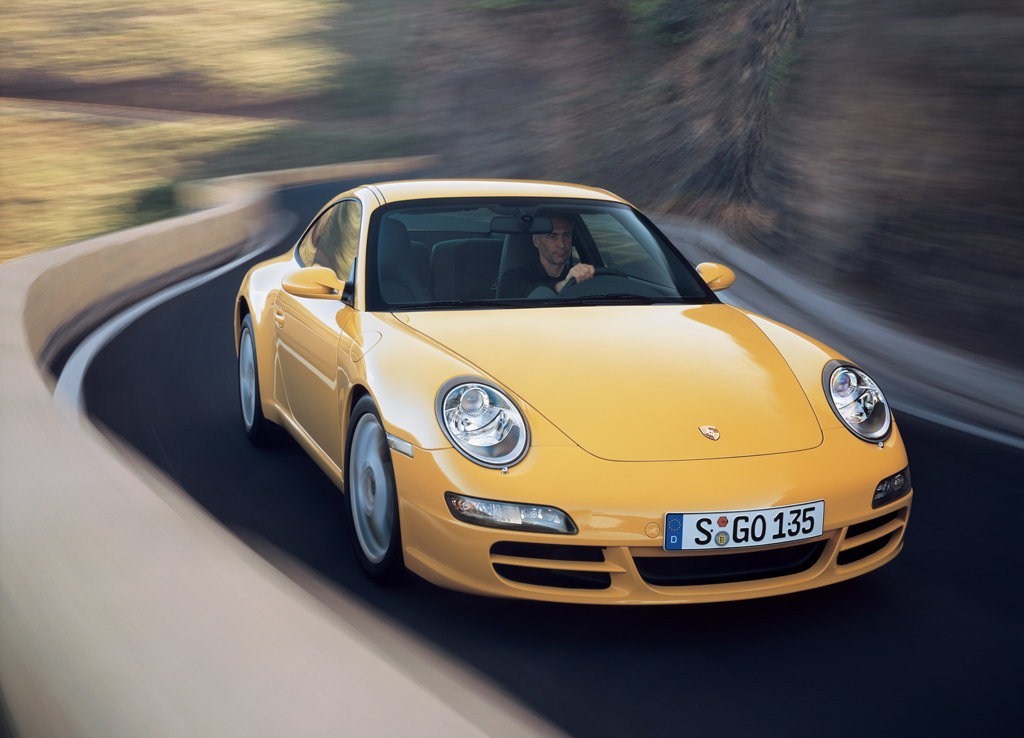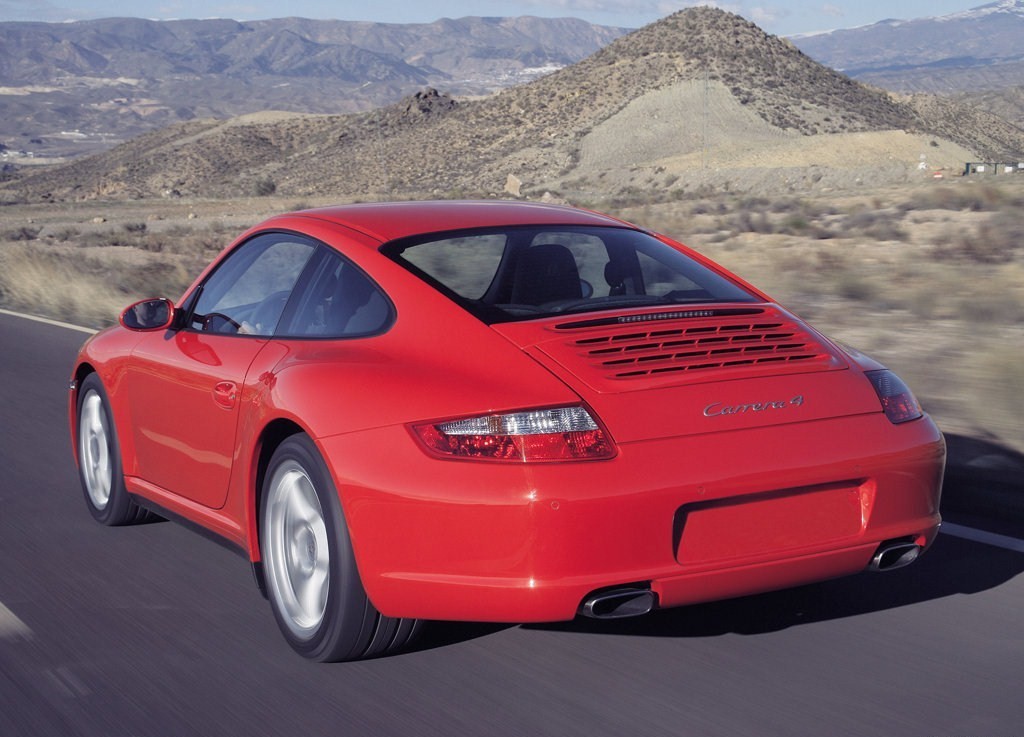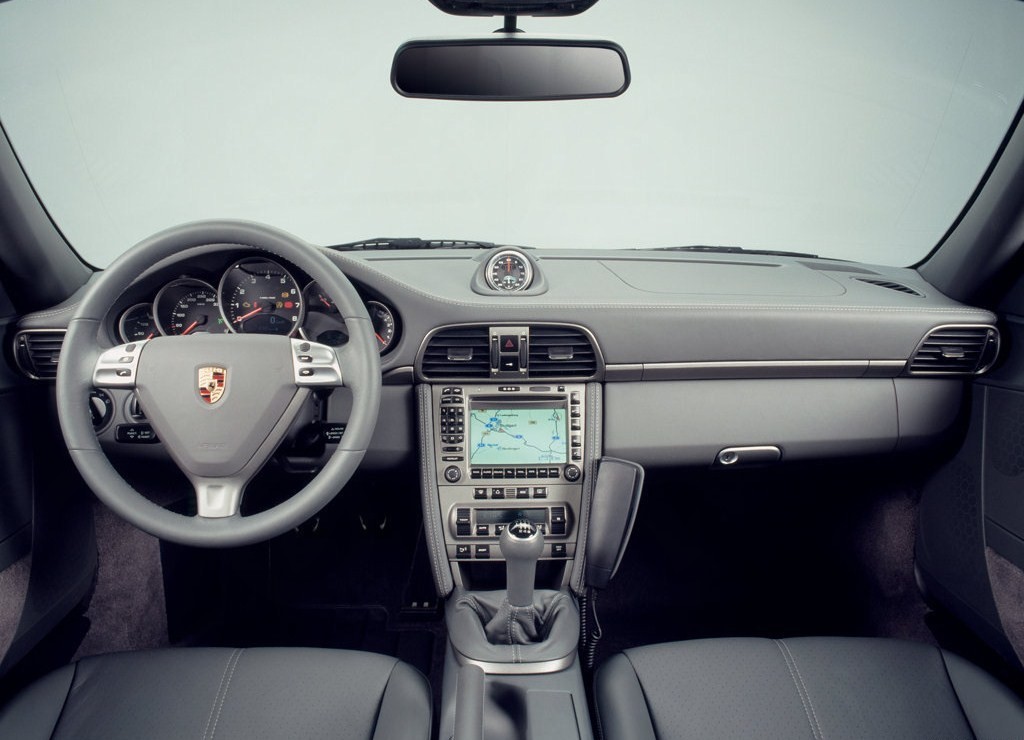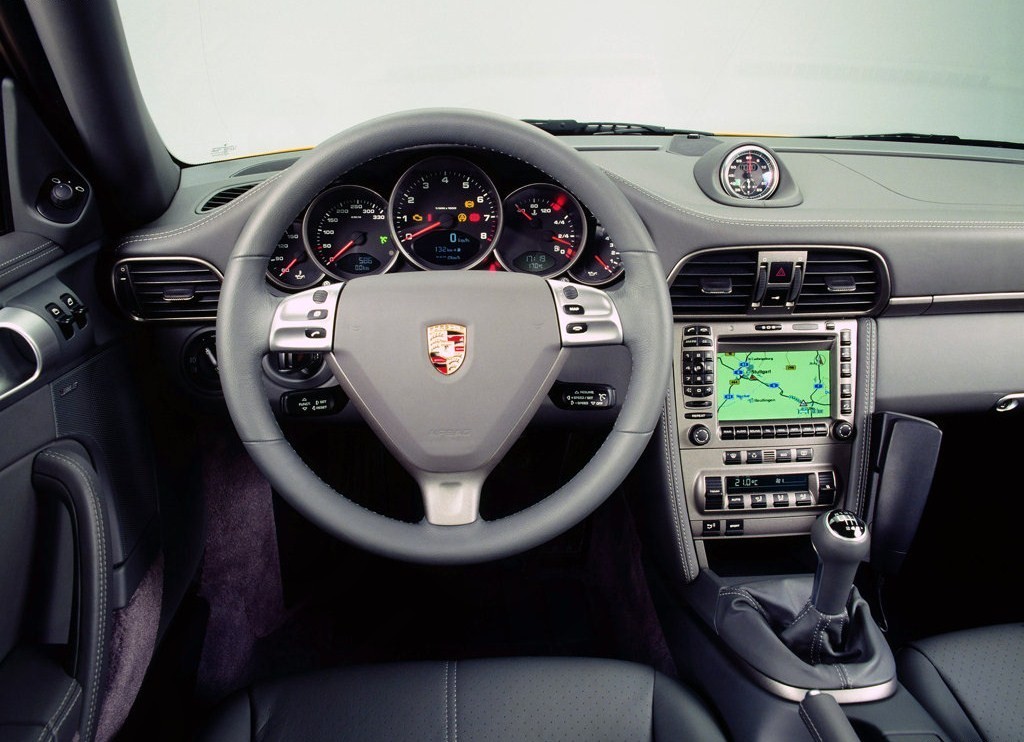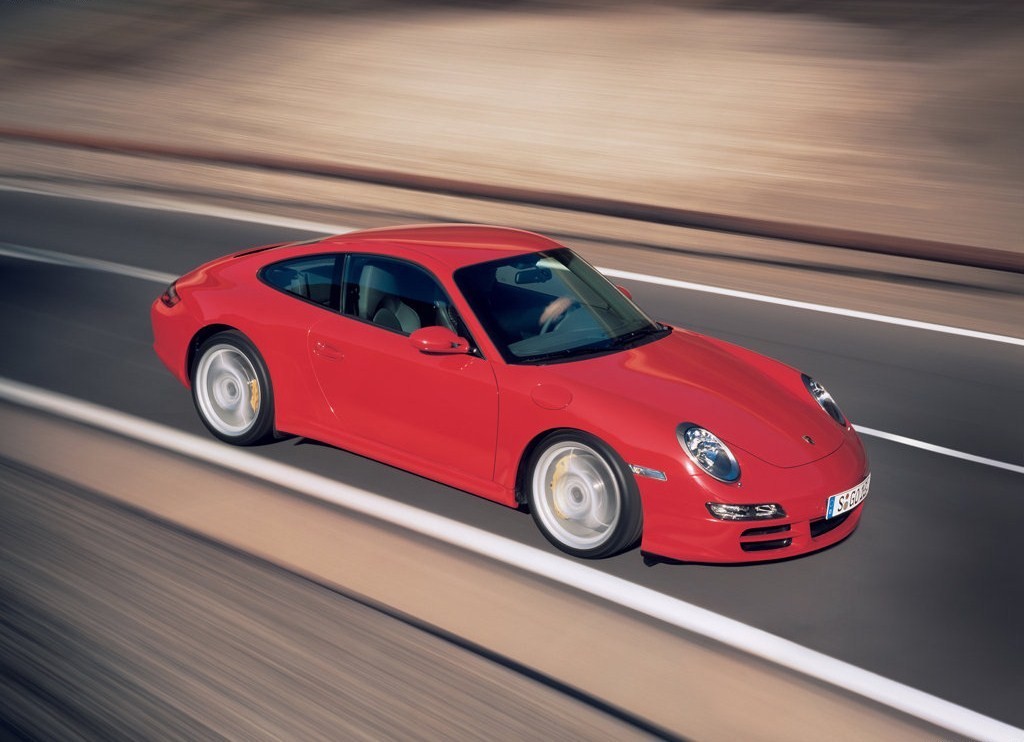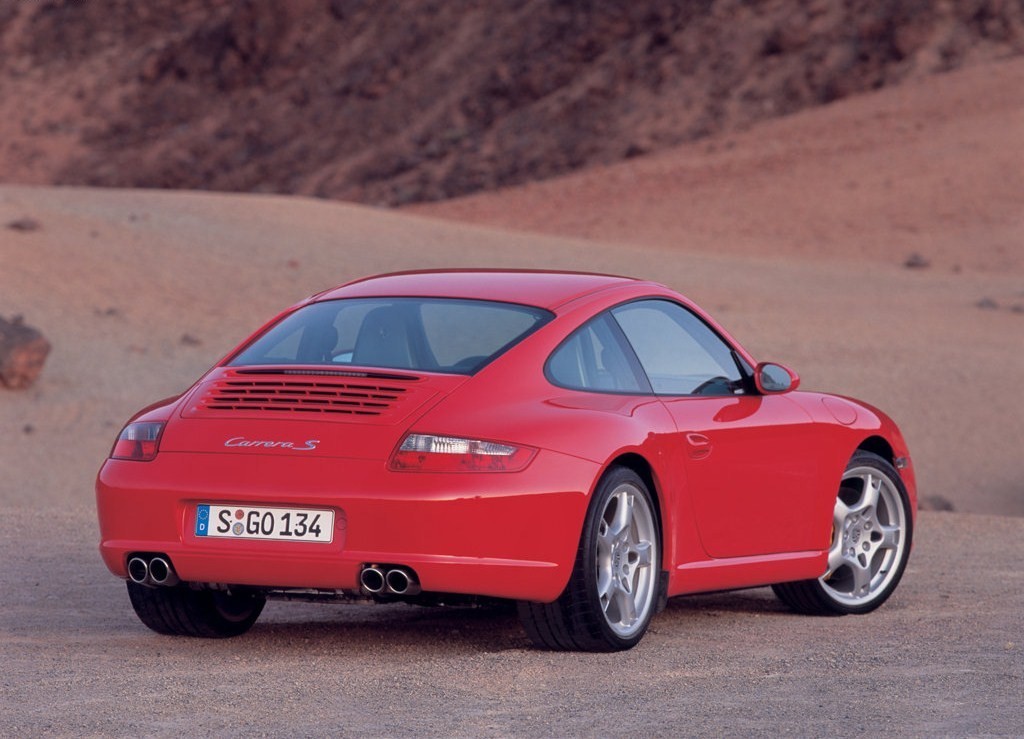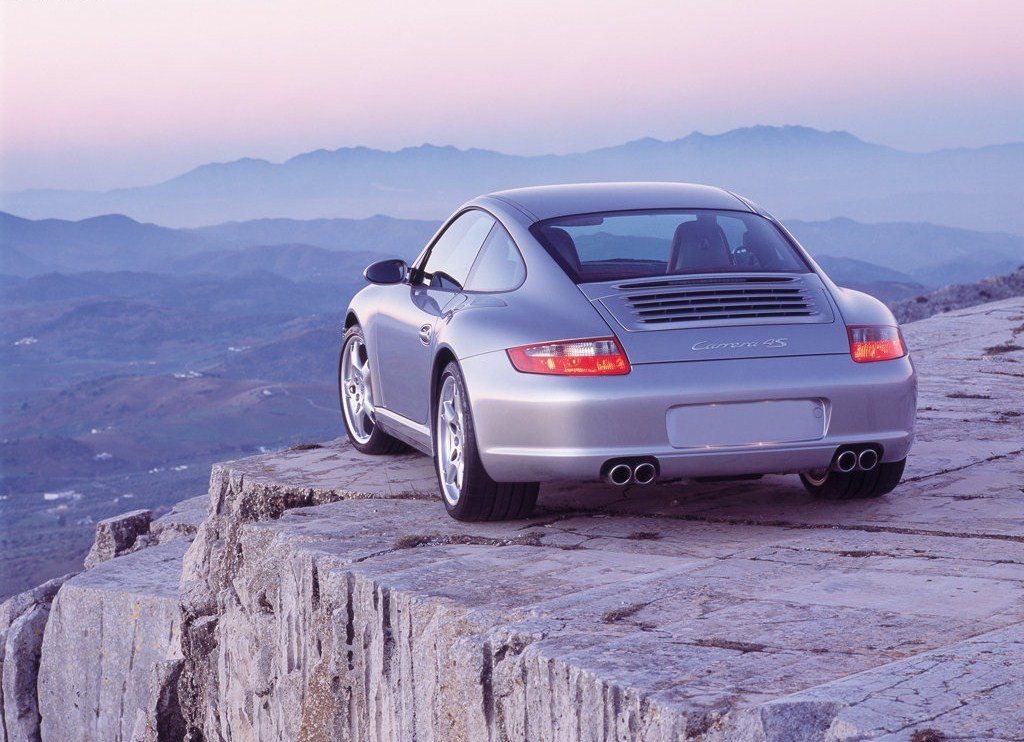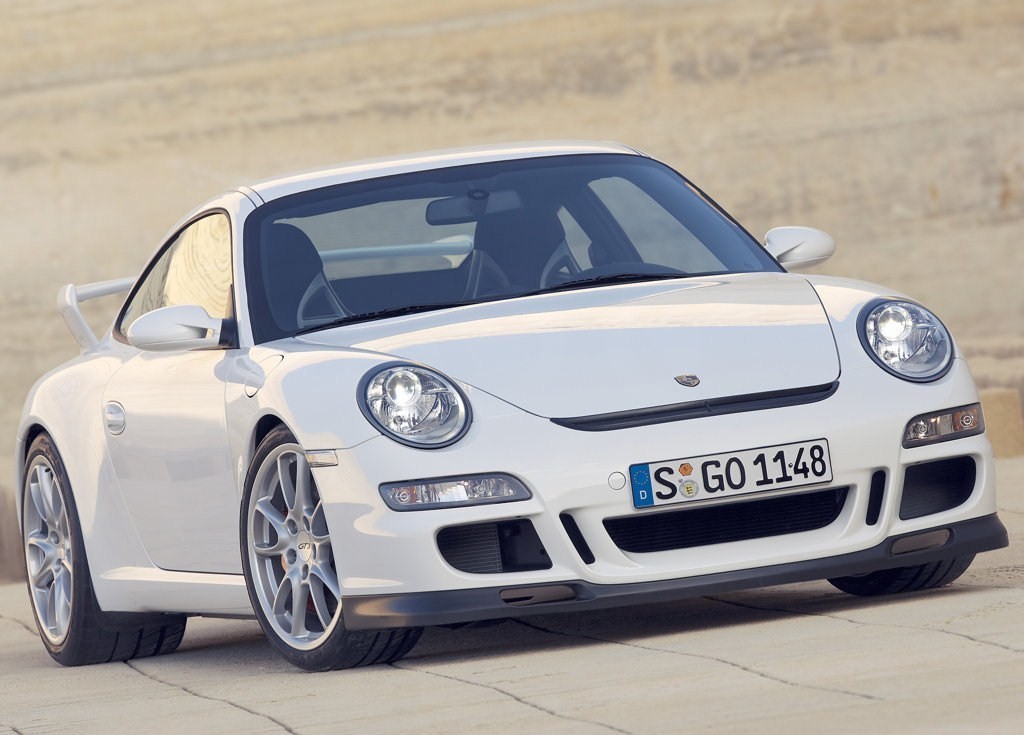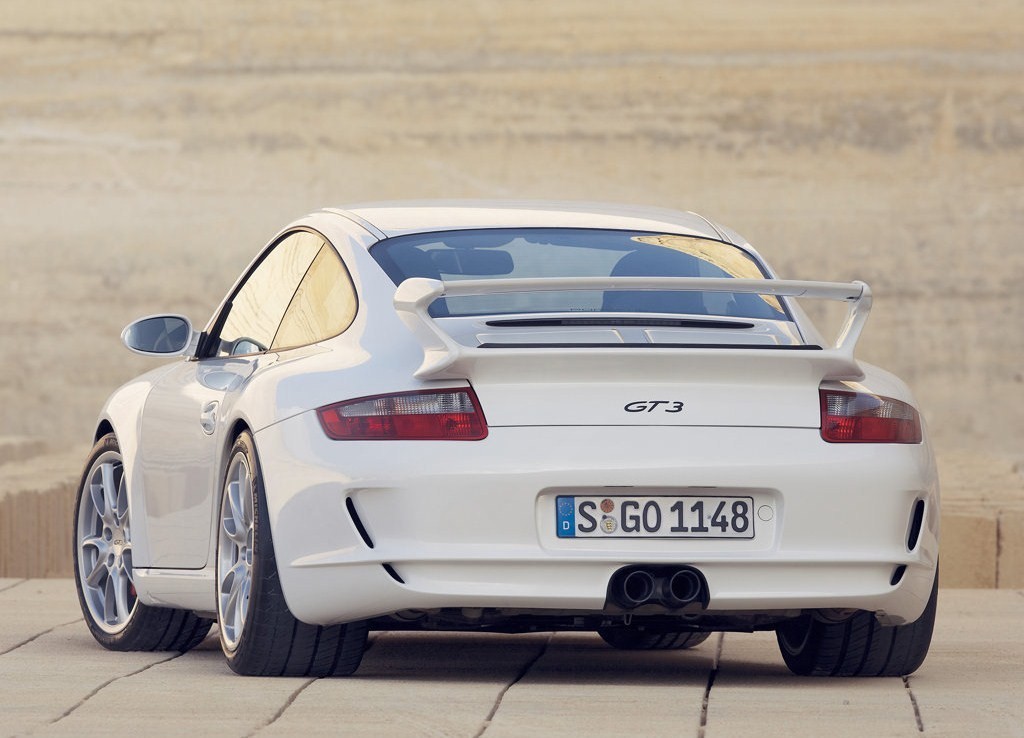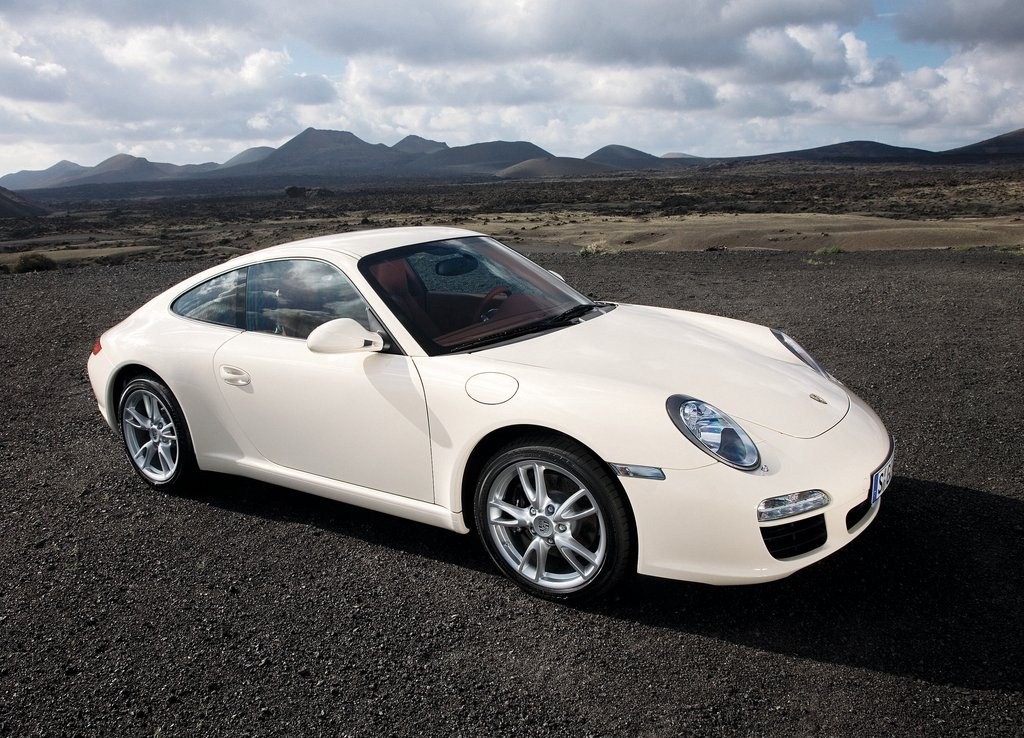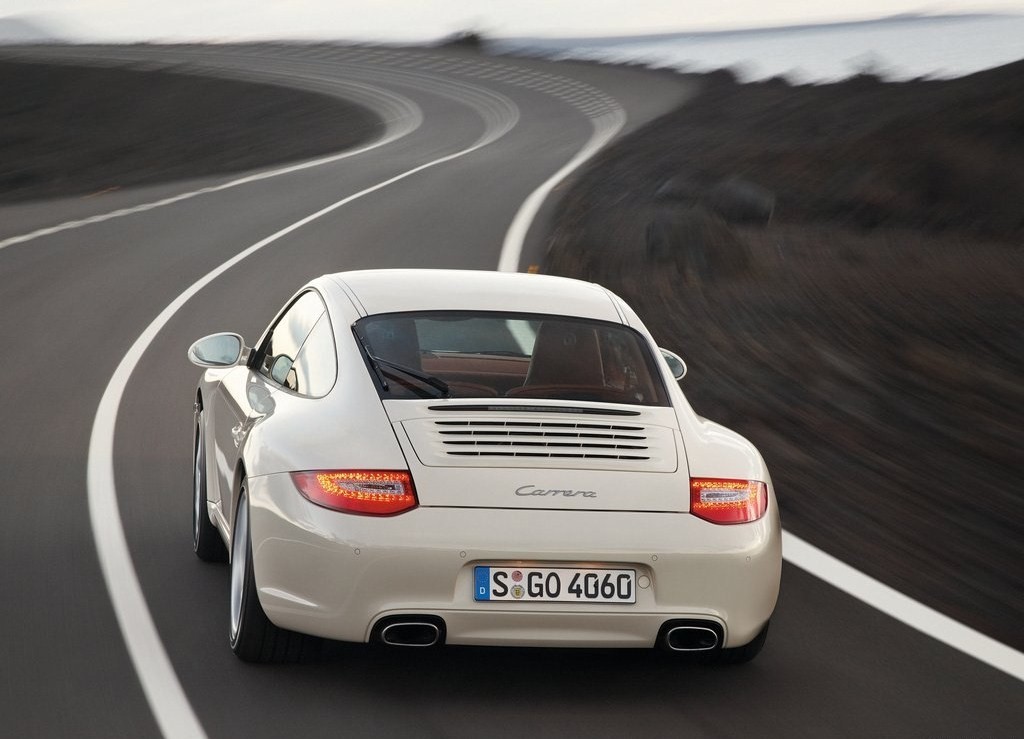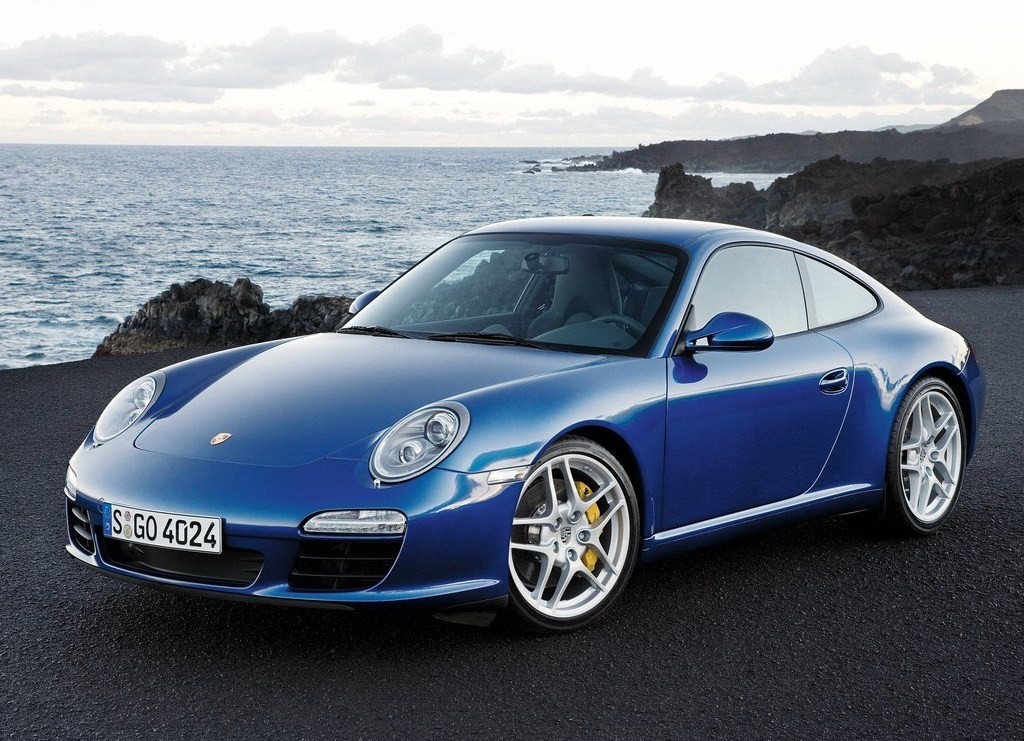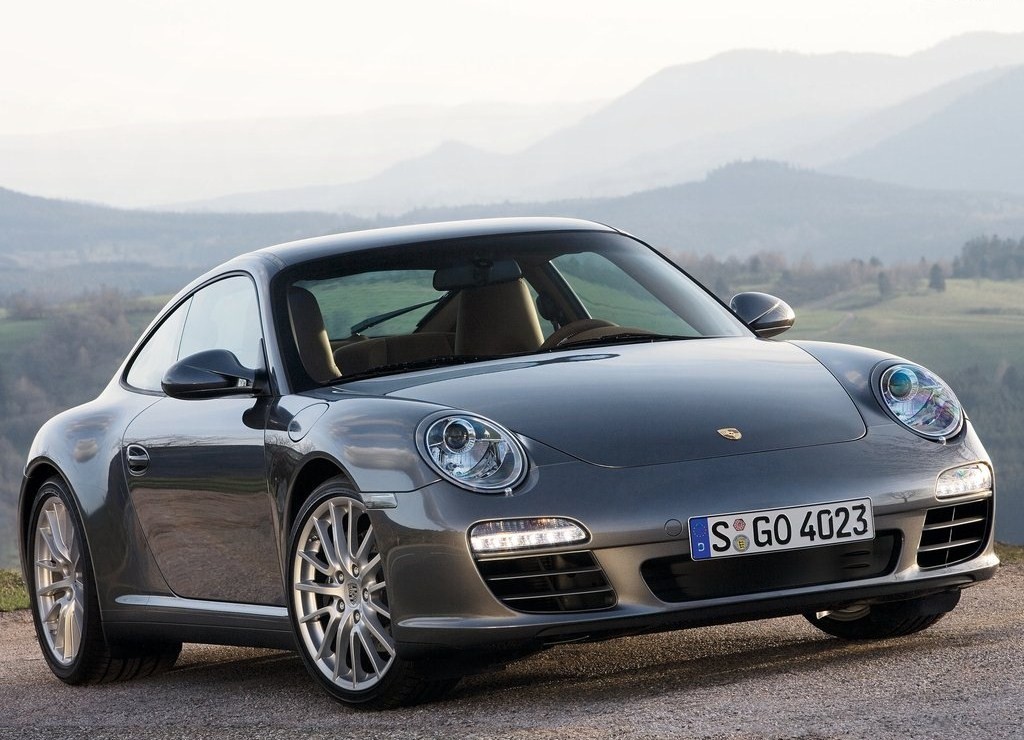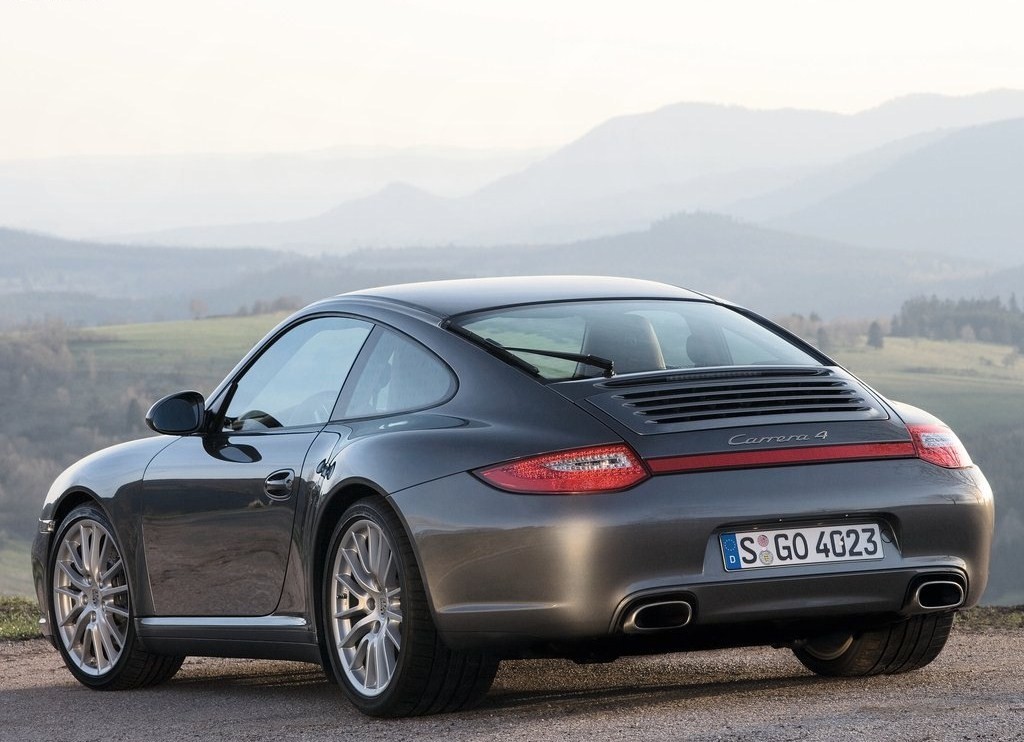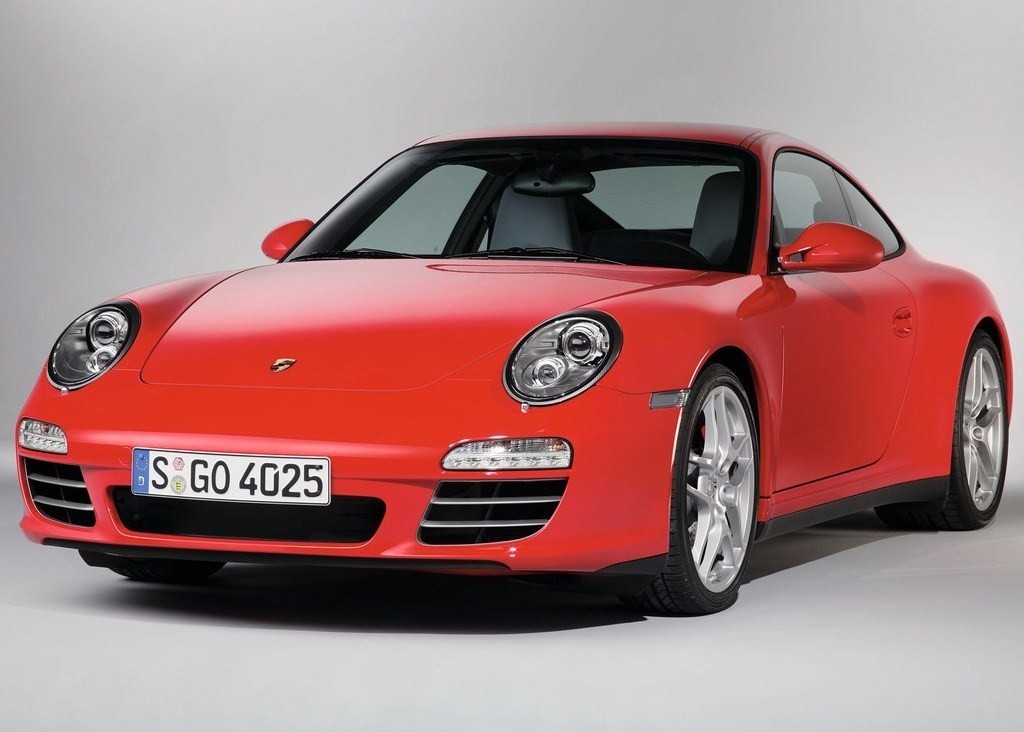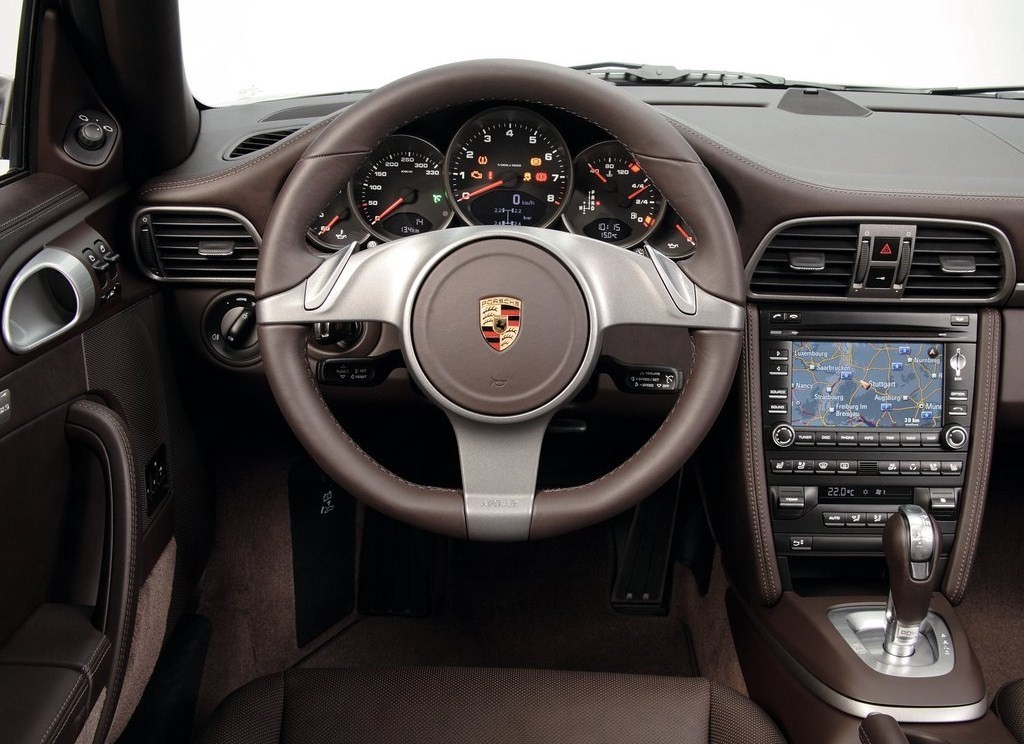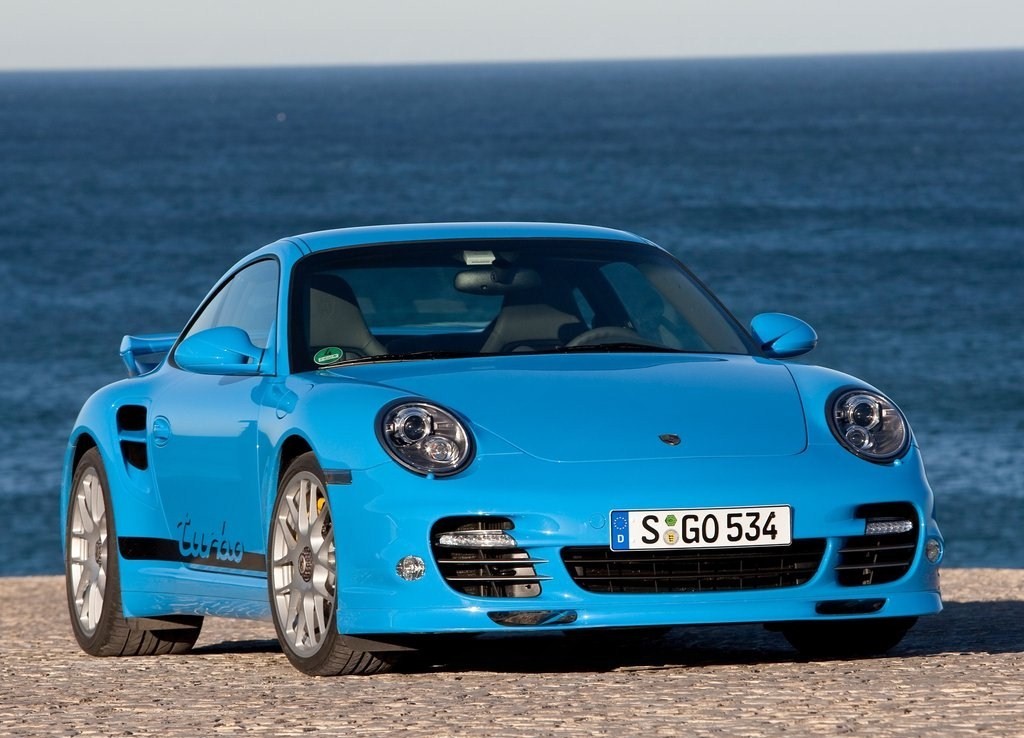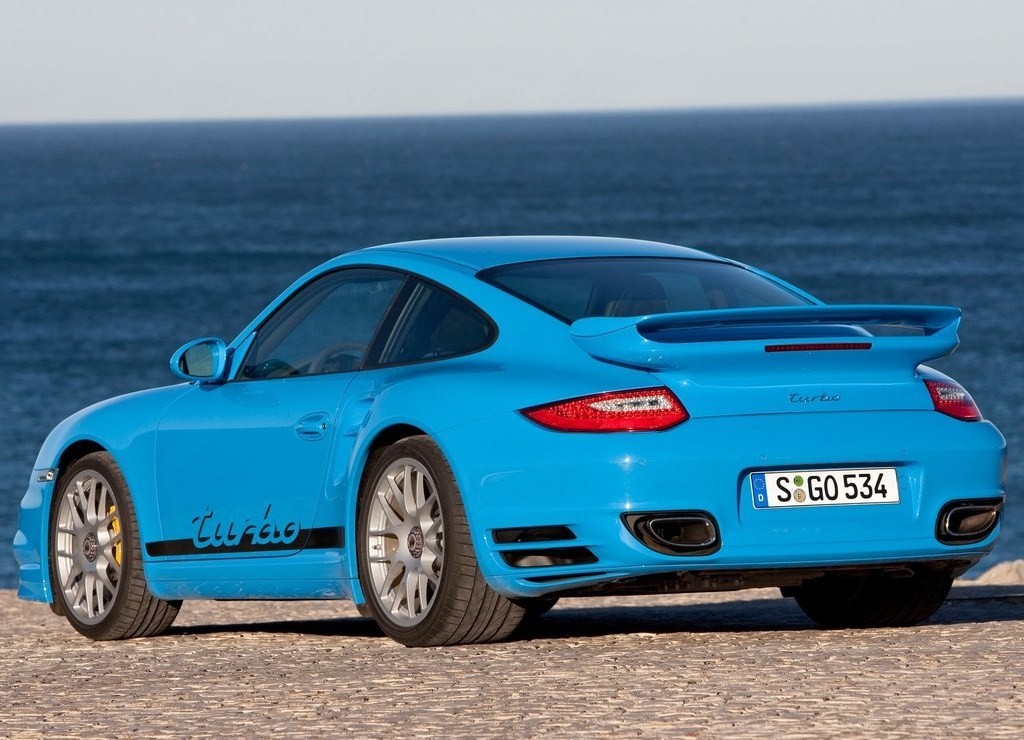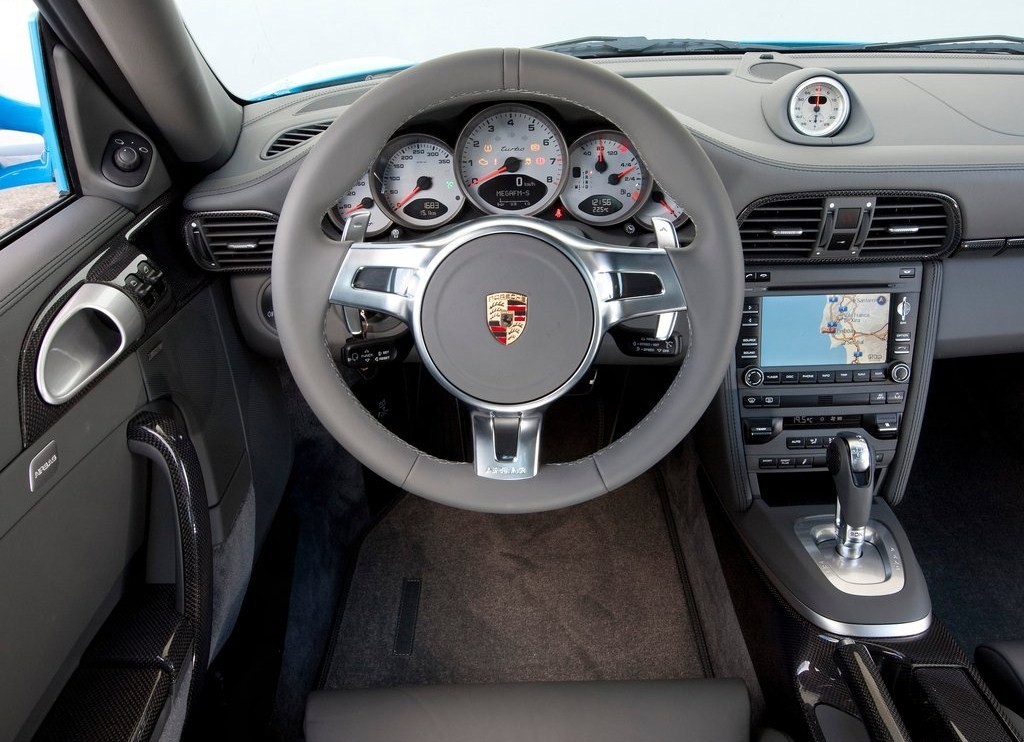
- Free-revving flat six-cylinder engines
- Refined, precise and quick-shifting manual transmission
- Supportive front seats
- Excellent ride/handling balance
- Variable ratio steering is accurate…
- … but lacks weight in initial movement off-centre
- Tiptronic transmission blunts performance
- Impractical rear seats
Review: Porsche 997.I 911 Coupe (2004-08)
Overview
Released in October 2004, the Porsche 997 Series I (997.I) 911 Coupe was a two-door fastback. Manufactured in Stuttgart, Germany, the 997 911 Coupe range initially consisted of the rear-wheel drive Carrera variants, with the all-wheel drive Carrrera 4 following in November 2005. The range was further expanded in 2006 with the Turbo (August) and GT3 variants (September), while a limited number of GT2 variants were available from March 2008. The full range is given in the table below.
Engines
The 3.6- and 3.8-litre horizontally-opposed, six-cylinder engines featured liquid-cooling, dry-sump lubrication, double overhead camshafts, four valves per cylinder and Porsche’s VarioCam Plus intake valve timing and lift system. The Turbo and Turbo S variants were fitted with 3.6-litre engines which featured parallel, variable geometry turbochargers.
Dimensions
Compared to the 996 911 Coupe , the 997 911 Coupe was 3 mm shorter (at 4427 mm), 43 mm wider (1808 mm) and 5 mm taller (1310 mm), though wheelbase length was unchanged (2350 mm). Furthermore, the 997 chassis achieved a 40 per cent increase in flexural rigidity and an eight per cent increase in torsional rigidity.
Suspension and steering
The 997 911 Coupe had MacPherson strut front suspension and multi-link rear suspension, and also introduced variable ratio steering.
| Variant | Year | Drive | Engine | Trans. | Peak power | Peak torque |
|---|---|---|---|---|---|---|
| Carrera | 2004-08 | RWD | 3.6-litre M96.05 petrol F6 |
6sp man., 5sp auto |
239 kW at 6800 rpm | 370 Nm at 4250 rpm |
| Carrera S | 2004-08 | RWD | 3.8-litre M97.01 petrol F6 | 6sp man., 5sp auto |
261 kW at 6600 rpm | 400 Nm at 4600 rpm |
| Carrera 4 | 2005-08 | AWD | 3.6-litre M96.05 petrol F6 |
6sp man., 5sp auto |
239 kW at 6800 rpm | 370 Nm at 4250 rpm |
| Carrera 4 S | 2005-08 | AWD | 3.8-litre M97.01 petrol F6 |
6sp man., 5sp auto |
261 kW at 6600 rpm | 400 Nm at 4600 rpm |
| Turbo | 2006-08 | AWD | 3.6-litre M97.70 twin-turbo petrol F6 | 6sp man., 5sp auto |
355 kW at 6000 rpm | 620 Nm at 1950-5000 rpm |
| GT3, GT3 RS |
2006-08 | RWD | 3.6-litre M97.79 petrol F6 |
6sp man. | 305 kW at 7600 rpm | 405 Nm at 5500 rpm |
| GT2 | 2008 | RWD | 3.6-litre M97.70 twin-turbo petrol F6 | 6sp man. | 390 kW at 6500 rpm | 680 Nm at 2200-4500 rpm |
AWD system
The Carrera 4 models were fitted with an all-wheel drive system which utilised a viscous multiple-plate clutch to send power to a central driveshaft which connected to the front differential to deliver between 5 and 40 per cent of the engine’s torque to the front axle.
The 911 Turbo, however, was fitted with an electronically controlled multi-plate clutch which could instantaneously transfer between 80 to 100 per cent of the engine’s torque from the rear axle to the front. On a dry road and under constant throttle, 60 per cent of the engine’s torque was directed to the rear axle. However, the system continuously monitored driving conditions (i.e. wheel rotation speeds, steeringle angle, longitudinal and lateral acceleration) and could send additional torque to the front axle to prevent lateral instability.
Safety equipment
Standard safety equipment for the 997 911 Coupe included dual front airbags, front seat-mounted side airbags, front door-mounted head airbags, ABS, electronic stability control, traction control and front seatbelts with pretensioners and load limiters. The all-wheel drive models were also fitted with two additional braking functions:
- ‘Brake Pre-Filling’, which closed the air gap between the brake pads and discs when sudden accelerator pedal lift-off was detected (improving initial brake performance); and,
- ‘Brake Assistant’, which detected when brake pedal pressure was applied quickly, but not with full force, and increased braking assistance.
Features
Standard features for the Carrera and Carrera 4 included 18-inch alloy wheels, a thirteen speaker Bose sound system with a six-disc CD player and MP3-compatibility, climate control air conditioning, satellite navigation, leather seats, twelve-way power adjustable front seats, cruise control, front fog lights, a leather-wrapped steering wheel, split and folding rear seats, a leather-wrapped steering wheel, remote central locking, power windows and heated mirrors, a height and reach adjustable steering wheel, driver memory settings (front seat and door mirrors), alcantara roof-lining, a trip computer, motion-sensing alarm and an immobiliser. The Carrera and Carrera 4 were also fitted with cross-drilled and ventilated 318 mm by 28 mm front brake discs and 299 mm by 24 mm rear discs, both fitted with four-piston black monobloc Brembo calipers.
The Carrera S and Carrera 4 S were further equipped with 19-inch alloy wheels with 10 mm lower sports suspension, bi-xenon headlights with washers, metallic interior highlights and Porsche Active Suspension Management (PASM), which provided selectable ‘normal’ and ‘sport’ modes for the adjustable dampers. The Carrera S and Carrera 4 S were also fitted with 330 mm by 34 mm front brake discs and 299 mm by 28 mm rear discs, both fitted with larger, reinforced red calipers.
The 911 Turbo was distinguished by its mass-reducing aluminium bonnet and door panels. The Turbo variants were similarly equipped to the Carrera S and Carrera 4S, albeit with a single CD player and upgraded brakes: 350 mm ventilated front discs with six-piston front calipers and 350 mm rear discs.
Porsche 997 911 GT3
Compared to Carrera, the GT3 omitted leather seats and a satellite navigation system, instead fitted with a four speaker sound system, single disc CD player, air conditioning, reacing seats, alcantara trim, ambient lighting, rear fog lights and tinted windows. The GT3 was also fitted with aluminium panels, the same braking package as the Turbo variant and a limited slip rear differential.
The GT3 RS was distinguished by its adjustable carbon-fibre rear wing, plastic rear boot and window, wider rear track and ‘Club Sport’ cabin, which featured a bolted rollcage, two carbon-fibre racing bucket seats, a six-point harness for the driver, pre-wiring for a battery master switch and a fire extinguisher.
Porsche 997 911 GT2
Compared to the 911 Turbo, the GT2 was 145kg lighter and fitted with larger compressor wheel, improved turbocharger housings and a special expansion-type intake manifold, enabling greater boost pressure. The GT2 was also distinguished by its 19-inch light alloy wheels with 235/35 front and 325/30 rear tyres, taller internal gear ratios, wider and stronger internal transmission cogs, a dual-mass flywheel, 22 per cent shorter gearshift travel and a mechanical limited-slip rear differential with 28 per cent locking action under power and 40 per cent in overrun, rear silencer, titanium exhaust pipes and upgraded braking package: ventilated and cross-drilled ceramic composite brake discs measuring 380 mm by 34 mm at the front and 350 mm by 28 mm at the rear, with six-piston monobloc front and four-piston monobloc rear calipers. Additional features included tyre pressure monitoring and a launch control system (‘Launch Assistant’).
Visually, the GT2 could be identified by its larger twin-deck spoiler, extra-wide rear wheel arches, larger side air intakes, rear three-quarter bumper gills, unique side skirts, twin titanium exhaust outlets, redesigned front bumper with an air outlet at the top, an unpainted lower chin and three large air inlets instead of the Turbo’s foglights. Inside, there were two-piece sports bucket seats with integrated head restraints, made from fiberglass and carbon-fibre, an Alcantara-wrapped steering wheel and suede finish for the headlining, centre console, door handles, armrests, gearshift and handbrake. The ‘Club Sport’ interior package was also available as a no-cost option.
Review: Porsche 997.II 911 Coupe (2008-11)
Overview
Released in October 2008, the 997 Series II (997.II) 911 Coupe introduced direct-injection engines for the Carrera, Carrera 4 and Turbo variants, a seven-speed double-clutch transmission (Porsche’s PDK or Porsche-Doppelkupplungsgetriebe) and cosmetic updates. The direct-injection engines were more powerful, lighter, had greater structural rigidity and 40 per cent fewer moving parts due to new timing chain technology and one-piece cylinder heads. The suspension also featured revised spring, damper and anti-roll bar settings, including an additional stop spring on the front and rear axles.
Visually, the 997.II 911 Coupe could be identified by its new front and rear bumpers, larger front air intakes, new front light units above the air intakes, daytime LED running lights and LED brake lights; the Carrera 4 variants also had a full-length rear reflector between the tail-lights and silver-coloured front air-dam strakes. Inside, there was a third-generation Porsche Communications Management (PCM) system, featuring a bigger 6.5-inch touch-screen.
| Variant | Year | Drive | Engine | Trans. | Peak power | Peak torque |
|---|---|---|---|---|---|---|
| Carrera | 2008-11 | RWD | 3.6-litre MA102 petrol F6 |
6sp man., 7sp DCT |
254 kW at 6500 rpm | 390 Nm at 4400 rpm |
| Carrera S | 2008-11 | RWD | 3.8-litre MA101 petrol F6 |
6sp man., 7sp DCT |
283 kW at 6500 rpm | 420 Nm at 4400 rpm |
| Carrera GTS | 2011 | RWD | 3.8-litre MA101S petrol F6 |
6sp man., 7sp DCT |
300 kW at 7300 rpm | 420 Nm at 4200-5600 rpm |
| Carrera 4 | 2008-11 | AWD | 3.6-litre MA102 petrol F6 |
6sp man., 7sp DCT |
254 kW at 6500 rpm | 390 Nm at 4400 rpm |
| Carrera 4 S | 2008-11 | AWD | 3.8-litre MA101 petrol F6 |
6sp man., 7sp DCT |
283 kW at 6500 rpm | 420 Nm at 4400 rpm |
| Turbo | 2009-11 | AWD | 3.8-litre MA170 twin-turbo petrol F6 | 6sp man., 7sp DCT |
368 kW at 6000 rpm | 650 Nm at 1950-5000 rpm |
| Turbo S | 2010-11 | AWD | 3.8-litre MA170 twin-turbo petrol F6 | 7sp DCT | 390 kW at 6250-6750 rpm | 700 Nm at 2100-4250 rpm |
| GT3 | 2009-11 | RWD | 3.8-litre M97.77 petrol F6 |
6sp man. | 320 kW at 7600 rpm | 430 Nm at 6250 rpm |
| GT3 RS | 2009-11 | RWD | 3.8-litre M97.77 petrol F6 |
6sp man. | 331 kW at 7900 rpm | 430 Nm at 6750 rpm |
AWD system
As per the 997.I 911 Turbo, the Carrera 4 and Carrera 4S were fitted with an electronically controlled multi-plate clutch. Unlike their predecessors’ viscous multi-plate clutch, this system enabled an infinitely variable front/rear torque split, though two-thirds of the engine’s torque was directed to the rear wheels in normal conditions. The Carrera 4 models were also fitted with a limited slip rear differential which had a 22 per cent locking action under power and 27 per cent locking action in over-run.
Safety equipment
Standard safety equipment for the 997.II 911 Coupe was also improved as the rear-wheel drive models were fitted with the ‘Brake Pre-Filling’ and ‘Brake Assistant’ functions (previously limited to all wheel drive models).
Features
Standard features extended to include auxiliary USB/iPod inputs, bi-xenon headlights with washers, Bluetooth connectivity and rear parking sensors. The Carrera and Carrera 4 were also fitted with bigger brakes, consisting of 330 mm by 34 mm front brake discs and 330 mm by 28 mm rear discs. The Carrera S and Carrera 4 S were also fitted with an upgraded PASM system which provided a firmer ride.
Released in August 2010, the Turbo S was fitted with 19-inch central-locking alloy wheels, directional headlights and features that were optional on the standard Turbo variant, including:
- Porsche Torque Vectoring (PTV), which consisted of braking the inner rear wheel when cornering to reduce understeer;
- The Sport Chrono package, including Launch Control and Porsche Active Drivetrain Mounts (dynamic engine mounts which utilised a magnetorheological fluid and an electric current to vary the damping stiffness between engine and body); and,
- Porsche Ceramic Composite Brakes (PCCB).
911 GT3
The 997.II GT3 had upgraded aerodynamics which provided almost double the downforce of its predecessor, stiffer springs and anti-roll bars, reduced body height and switchable electronic stability and traction control systems. Furthermore, the front brake discs were increased to a 380 mm diameter (previously 350 mm) and had a composite structure with the friction discs made of grey cast iron and the brake covers of light aluminium; these components were connected by radially-arranged steel pins. The GT3 was also fitted with a mechanical limited-slip differential which provided a 28 per cent asymmetrical locking effect during acceleration and 40 per cent on over-run. Visually, the GT3 could be identified by its modified air intakes and outlets and lighter alloy wheel with a one-piece centre-lock.
The GT3 RS was distinguished by its lowered ride height, specific calibration for its electronic stability control system, wider tracks and larger carbon-fibre rear wing. The GT3 RS was also fitted ‘Porsche Active Drivetrain Mounts’. Visually, the GT3 RS could be identified by its unique front and rear bumpers with larger air intakes, titanium exhaust with dual centre rear outlets, bright red front air-dam surround, wing mirrors, decals and wheels.
911 Carrera GTS
Released in January 2011, the rear-wheel drive Carrera GTS was powered by a more powerful 3.8-litre engine which had a new resonance intake system. Compared to the Carrera S on which it was based, the Carrera GTS had the same 44 mm wider rear-end as the all-wheel drive models, with front and rear track increased by 2 mm and 32 mm, respectively.
Visually, the Carrera GTS could be identified by its 19-inch ‘RS Spyder’ black-painted alloy wheels with 235/35 ZR19 front and 305/35 ZR19 rear tyres, SportDesign front bumper with a black spoiler edge and black side skirts. The Carrera GTS was similarly equipped to the Carrera S, but distinguished by its sports seats with Alcantara and SportDesign steering wheel, gear lever and handbrake; the rear seats were also omitted, though could be optioned at no extra cost.
Brochures
- Brochure: Porsche 997.II 911 Coupe GT3 (February 2009)
- Brochure: Porsche 997.II 911 Coupe Turbo and 911 Cabriolet Turbo (May 2009)
- Brochure: Porsche 997.II 911 Coupe, Cabriolet and Targa (March 2010)
Related links
